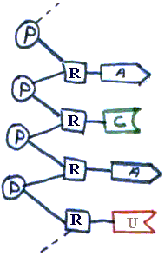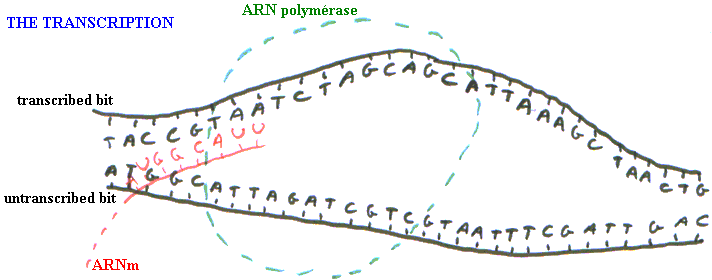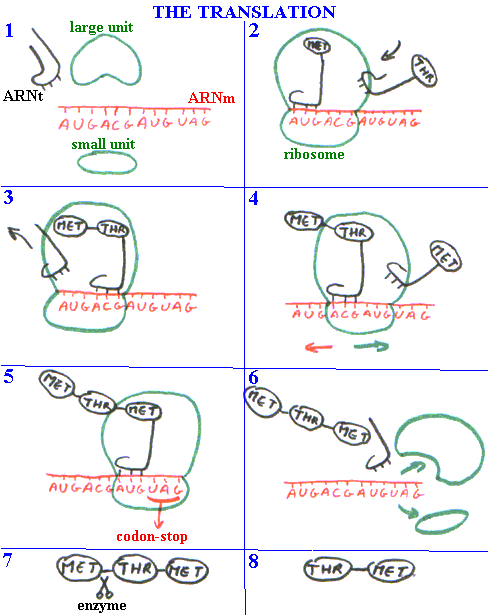Le coin des amatheurs de sciences version 2 
The sections of the site : The site  FORUM
FORUM  The space
The space  The genetics
The genetics  Medicine
Medicine  Physics
Physics  Tintin and science
Tintin and science  Ecology - Nuclear energy
Ecology - Nuclear energy  Mysteries of the history
Mysteries of the history  Humour
Humour  Diverse
Diverse
Le coin des amatheurs de sciences version 2 
The sections of the site : The site  FORUM
FORUM  The space
The space  The genetics
The genetics  Medicine
Medicine  Physics
Physics  Tintin and science
Tintin and science  Ecology - Nuclear energy
Ecology - Nuclear energy  Mysteries of the history
Mysteries of the history  Humour
Humour  Diverse
Diverse
To understand this page, you should firstly read Bases of the genetics.
The genes determine our characters by the intermediary of proteins : each gene orders the expression of a particular protein which will act then. For example, the color of the eyes is determined by an enzyme (one of the types of proteins) called melanine. According to genes of an individual, its cells will produce different quantities of melanine. Produced once, this one circulates in blood and, reaching the eyes, colours them. Thus, more one produces melanine, more our eyes approach chestnut. But how does one pass of one gene to corresponding protein ?
The first important report is that there is an intermediary. Indeed, the proteins are synthesized in the cytoplasm of the cells whereas the DNA is located in the core (see framed) and that it cannot leave there. This intermediary, which could be identified and observed, is called ARNm (ribonucleic acid messenger). Its composition is very close to that of the DNA. It is like the DNA made up of a nucleotide sequence. However, it comprises one bit and the désoxyribose of the DNA is replaced there by another sugar, ribose (noted R). It is thus schematized as follows :

The first stage of the synthesis of proteins is thus the synthesis of ARNm. This stage called transcription is carried out by an enzyme, the ARN polymerase. This enzyme opens the molecule of DNA by separating the nitrogenized bases. It moves along genes by setting up nucleotides opposite those of the bit of transcribed DNA, by respecting the complementarity of the bases (except that in ARNm, the nucleotide T is replaced by U for uracil). Once that the whole of gene was transcribed, ARNm is detached from the DNA and moves towards the cytoplasm of the cell.
The second stage, the translation, utilizes two other components : ARNt (ARN of transfer) and ribosomes. ARNt is a protein able to be fixed on a side on nucleotide triplets of ARNm (a triplet is called codon) and to fix other side an amino acid (the amino acids, 20, are the components of proteins). Ribosomes are small particles of the cytoplasm made of two units, large and small (symbolized in the form of half-circles). These two units permet them to fix around ARNm like a pearl on a wire. The great unit contains two « sites », each one being able to contain ARNt.
The translation is possible because it is coded by a universal (almost, a small number of alive beings not having the same one) code : the genetic code (available here). This one makes it possible to associate almost each codon an amino acid. Let us code not coding for an amino acid are called code-stop or code nonsense. They determine the end of the synthesis of a protein. The translation proceeds as follows :
- the initiation : The first codon of ARNm is always AUG. Thanks to this codon, two units of ribosomes will be able to fix itself around ARNm. As this codon corresponds to the amino acid methionine, ARNt corresponding to this acid comes to be fixed on the codon. Then a methionine molecule sets on the other side of ARNt.
- the elongation : On the codon according to, in the second site of ribosome, comes to set ARNt corresponding, carrying with him the amino acid corresponding. The presence of the two amino acids one beside the other causes a chemical reaction which binds them. Then first ARNt is detached, and ribosome advances of a codon on ARNm. The operation is then repeated. Thus, step by step, the whole of ARNm is translated into protein.
- the termination : The synthesis stops when ribosome meets a codon-stop. At this time, the unit is dissociated : ribosome, ARNm, ARNt and the polypeptide chain (i.e. the sequence of the amino acids) separate. Ribosome also separates into two under-bet which will be used again for another translation. A last enzyme comes to detach from the chain methionine corresponding to codon initiating AUG. The protein is formed.
To synthesize, here the schematization of the two stages :

